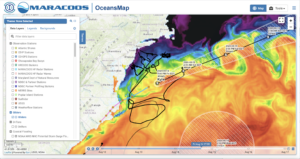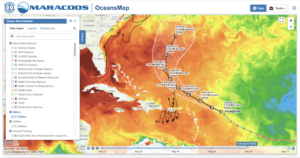-
A milestone week for distributed autonomy
Posted on August 14th, 2020 No commentsJust a quick shot of Kyle off the Mid Atlantic from OceansMap. Kyle is forecast to hit the warm water in the many Gulf Stream meander crests as it travels northeast. Below that is a view of Josephine as it skirts the edge of the warm water on its path just east of the Caribbean’s Windward Islands toward our friends in Bermuda operating the BIOS gliders. Two tropical storms, but the significance for us will be looking at how the new version of HWRF performs in each.


Isaias was a grand success with hurricane gliders deployed along its entire track through the IOOS regions CARICOOS, SECOORA and MARACOOS.
A science storm. Strong enough to get our attention and motivating even broader collaborations with scientists from the Argo float, underwater Glider and surface drifter communities starting to coordinate their observations and science through NOAA OAR’s Ocean Observing for Extreme Events (OOEE) working group. But Isaias used the previous version of HWRF that did not benefit from the modern suite of data assimilative ocean models.
Josephine and Kyle are being forecast using the new version of HWRF, version 13.0.0, made operational by NWS on August 5 at 12Z. We have already seen some excellent new HWRF features like improved bathymetry and an initial ocean condition derived from the NOAA global RTOFS that, in turn, is derived from the data assimilative Navy GOFS model shown in the figures above. Josephine and Kyle are the first two storms where both operational hurricane models, HWRF and HMON, have an initial ocean condition that can trace its roots to a data-assimilative ocean model. For the first time we have complete end-to-end data flow from the Hurricane Glider Picket Line to both operational hurricane models. Construction of the value chain running from ocean data delivered by a distributed network of autonomous ocean gliders to inclusion in operational forecasts is now complete.
It took so many people, and a process we began in 2014, to deliver this week on the promise of distributed autonomy for hurricane forecasting. The Concept of Operations (the ConOps as we call it) for this is new. Different gliders on different missions operated by different groups funded for different purposes by different government agencies like NOAA, Navy, NSF, industry partners like Shell in the Gulf or Orsted in the Mid Atlantic, or foundations like Vetlesen in the Caribbean, all contributing their near real time quality-controlled data in standard formats through the IOOS Glider DAC so that it can be delivered via GTS to the global modeling centers for improved hurricane forecasts. We are a distributed team with so many collaborators from NOAA OAR, NOS and NWS, the Navy, IOOS and its North Atlantic hurricane-prone Regional Associations (MARACOOS, SECOORA, GCOOS and CARICOOS), industry partners (energy sector, data management, glider manufacturers, sensor manufacturers) and academics from the Caribbean to the Gulf of Mexico to the Gulf of Maine. We have dedicated time and effort to deliver the technology, the scientific justification, and the real time data streams we need to support improved forecasts for all. We have demonstrated that by engaging the many strengths of our distributed community, it can be done.
Work hard, have fun, change the world. Thank you Doug Webb for these words to live by.
Happy Friday All.
-
RUCOOL Updates: June & July, 2020
Posted on August 12th, 2020 No commentsDespite the COVID-19 pandemic, RUCOOL remains active. Core technologies (storm gliders, HF-Radar and the Tuckerton meteorological station) were deemed critical research tools based on national security requirements and continue to be supported. These activities are guided by an operations plan that maintains recommended COVID best practices.
State
- Working with Atlantic Shores Offshore Wind, RUCOOL installed a wind LiDAR (Light Detection And Ranging) instrument alongside the causeway leading to RUMFS in Tuckerton, NJ. This fully autonomous sensor platform, owned and operated by Atlantic Shores, will provide observations of the atmospheric wind profile for the next several years, and provide vital information on the wind to stakeholders in the area.
- RUCOOL continues to participate in the public comment actions of both BOEM and NJBPU to contribute our expertise on ocean and atmospheric related monitoring and mitigation as it applies to the implementation of the offshore wind industry along the New Jersey and Mid-Atlantic coasts.
- The RUCOOL Education Team worked on the Virtual 4-H STEM Ambassadors program that supported 60 teens from Trenton, Union, Atlantic City, Passaic, New Brunswick, and Newark in an online summer program.
- Glider RU34, a new Slocum glider purchased for the Orsted ECO-PAM project, was deployed on July 29. The glider is equipped with the passive acoustic sensor designed to track vocalizing right whales in the area within and around Orsted’s Ocean Wind lease area off of NJ. Within hours of deployment, the glider identified tagged marine animals.
- On July 22, a catamaran flipped off the NJ coast, and was left to drift when the operators were rescued. The derelict boat became a drifting marine hazard. Operational Oceanography Graduate Student Joe Anarumo ran several drift simulations that predicted the current and future locations of the boat, guiding the recovery effort.
- The first two Masters of Operational Oceanography students will be defending their theses in August! They have already acquired jobs as oceanographic data analysts at NOAA CO-OPS and a consulting company. The second cohort of students are preparing for classes this fall. Students will ‘adopt-an-instrument’ and follow the full life-cycle collection of data this fall for improved hurricane forecasting, ocean acidification monitoring, and offshore wind assessment.
- The R/V Arabella, Rutgers’ flagship research vessel throughout the 90’s and early 2000’s, returned to service on May 20, 2019. Progress has been made in recent months to enhance capabilities and meet specifications largely outside of typical operations, with a short term goal of qualifying as a support vessel for local, sustainable wind energy development offshore. Bon voyage, Arabella!
National
- During the busiest hurricane season ever through July 31, the RUCOOL glider team organized glider deployments throughout the Mid Atlantic, funded by NOAA. Partners this year include UMass Dartmouth, Virginia Institute of Marine Science, the University of Delaware, SUNY Stony Brook, Monmouth University and the US Navy. In July, RUCOOL, in partnership with Monmouth University, deployed two US Navy gliders along the NJ Coast. Additionally, RU33 was deployed in support of the NOAA Hurricanes project. These three gliders are the first in what is expected to be a fleet of 7-10 gliders in the mid-Atlantic this summer focused on studying the ocean physics that impacts hurricane intensity. Information on and data from these gliders can be accessed at https://oceansmap.maracoos.org/ and https://marine.rutgers.edu/cool/data/gliders/
- RUCOOL maintains the high profile Hurricane Blog. It documents in real-time research findings focused on Fay, Gonzalo, Hanna and Isaias. The blog site (https://rucool.marine.rutgers.edu/blog/category/hurricanes/)is circulated by NOAA leadership and was distributed through the US IOOS Eyes-on-the-Ocean as a recommended data resource.
- The RUCOOL Education team’s Polar Literacy project is creating replicable means of bringing polar education to informal learning environments, extending our understanding of how polar education initiatives can be delivered to youth, and designing a professional development model to improve the capacity for Polar Region researchers to craft meaningful broader impacts. This summer we are offering several virtual online weeklong programs for middle school youth including July 27-31 Ohio 4-H Program, July 27-31 The Franklin Institute, PA, August 3-7 NJ 4-H (Newark), August 10-14, NJ 4-H (Trenton).
- Given the response to COVID, The NSF funded residential summer internship program, RIOS, had to be quickly reimagined. Working with NSF and the Data Labs project team, we were able to offer fully virtual experiences to an exceptions cohort of students across the country, including all time zones between Guam and Puerto Rico See https://datalab.marine.rutgers.edu/2020-virtual-reu/.
- The Data Labs team, in partnership with Rutgers RIOS, hosted an 8-week Research Experience for Undergraduates (REU) program for 16 students across the country, including Alaska, Guam and Puerto Rico. The experience started with a 2-week workshop with daily Zoom sessions on working with large datasets, an introduction to Python programming, science communication and career and graduate student panels. Students then spent 6-weeks working with mentors across the country on individual research projects. Their final posters are available on the project site, along with a map.
- The Data Labs team continues to work with faculty partners on the Data Labs Notebook which will be pilot tested this fall by 15 faculty. We are also continuing to work with our 2020 Fellows as they finalize their projects.
- The Data Labs Blog continues to feature articles on Ocean Observing Education, Python tutorials and examples of Labs.
International
- Travis Miles joined Scott Glenn on the NOAA Global Ocean Monitoring and Observation (GOMO) Program, specifically to work on their Ocean Observing for Extreme Events (OOEE) Team. The team is coordinating glider, Argo and surface drifter deployments for the 2020 hurricane season. Response to Isaias was the first coordinated event.
Student Awards
- Congratulations to Jessica Valenti on being selected to receive a National Science Foundation Postdoctoral Award. Using the Rutgers University Marine Field Station’s larval fish collection spanning the last 30 years, Jessica will investigate microplastic ingestion in larval fish from past and present to better understand the potential for microplastic accumulation in larval fish predators and examine larval fish characteristics that may influence microplastic ingestion. In addition, Jessica will help improve methods commonly used to identify microplastics, mentor undergraduate students on independent research projects.
Newly Funded Research
- US Integrated Ocean Observing System (IOOS), NOAA, 2020-2021, “Mid Atlantic Regional Association Coastal Ocean Observation System” ($4,053,639), S. Glenn.
- Office of Naval Research, 2020-2022, “Onboard Processing of Slocum Glider Velocity Profiles” ($545,809), T. Miles.
- Consortium for Ocean Leadership (through NSF), 2020, modification to “OOI Educational Support and Synthesis Based on the Initial Phase,” ($20,000), S. Glenn.
Papers Published: (**Current or Former Graduate Student or Postdoctoral Researchers)
- Beaird, N. L., Shroyer, E. L., Juranek, L. W., Hales, B., & Goñi, M. A. 2020. Nutrient‐rich gravity current formed by upwelling in Barrow Canyon: High‐resolution observations. Journal of Geophysical Research: Oceans, 125, e2020JC016160. DOI: 10.1029/2020JC016160
- Sherman, J.,, Gorbunov, M., Schofield, O., Falkowski, P. 2020. Photosynthetic energy conversion efficiency in the West Antarctic Peninsula. Limonlogy and Oceanography. DOI: 10.1002/lno.11562
- Carvalho, F., Gorbunov, M., Haskins, C., Oliver, M. J., Kohut, J., Aragon, D., Schofield, O. 2020. Mapping variable chlorophyll fluorescence using autonomous underwater gliders. Limnology and Oceanography Methods. DOI:10.1002/lom3.10380PDF
- Eichhorn, M., Aragon, D., Yuri A.W. Shardt, Hugh Roarty. August 2020. Modeling for the performance of navigation, control and data post-processing of underwater gliders. Applied Ocean Research Volume 101. DOI:10.1016/j.apor.2020.102191
RUCOOL Meetings & Conferences
- Though there were no in person meetings due to COVID, there were plenty of virtual meetings during the last two months: MARACOOS Board Meetings (several meetings), LTER Executive meeting, SCAR West Antarctic Working Group, Marine Technology Society Board Meeting, MAC Fish Habitat Workshop, Microrider Training 3 Day Workshop, Mid Atlantic Harbor Operations Meeting, USCG Wind Turbine Mitigation Meeting, Presentations to several local NJ Schools on various oceanography topics, Modeling, Prediction and Sensor Network for Coastal Flooding on the US East Coast, Weekly GOGO OOEE Meetings, Biweekly National Academies’ Ocean Studies Board meetings on the US Contribution to the Ocean Decade, and on Diversity, Equity and Inclusion in Ocean Sciences, Weekly NOAA Science Advisory Board (SAB) Environmental Information Services Working Group reviewing NOAA’s response to the Weather Act, Interagency Ocean Observing Committee (IOOC) meeting on the UN Ocean Decade, IOOS Data Management Monthly Call.



